charging MITSUBISHI LANCER 2005 Owner's Manual
[x] Cancel search | Manufacturer: MITSUBISHI, Model Year: 2005, Model line: LANCER, Model: MITSUBISHI LANCER 2005Pages: 788, PDF Size: 45.98 MB
Page 393 of 788
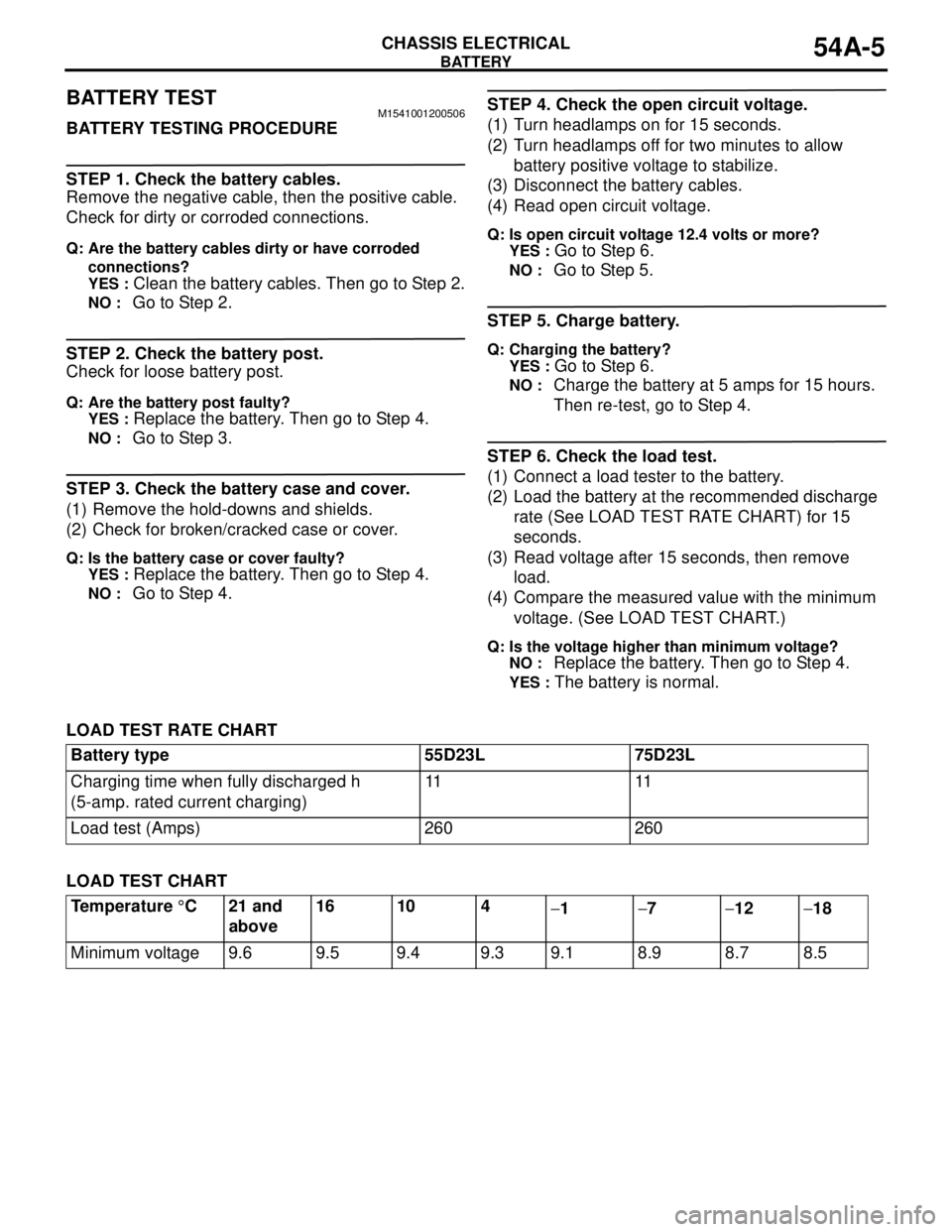
BATTERY
CHASSIS ELECTRICAL54A-5
BATTERY TESTM1541001200506
BATTERY TESTING PROCEDURE
STEP 1. Check the battery cables.
Remove the negative cable, then the positive cable.
Check for dirty or corroded connections.
Q: Are the battery cables dirty or have corroded
connections?
YES :
Clean the battery cables. Then go to Step 2.
NO : Go to Step 2.
STEP 2. Check the battery post.
Check for loose battery post.
Q: Are the battery post faulty?
YES :
Replace the battery. Then go to Step 4.
NO : Go to Step 3.
STEP 3. Check the battery case and cover.
(1) Remove the hold-downs and shields.
(2) Check for broken/cracked case or cover.
Q: Is the battery case or cover faulty?
YES :
Replace the battery. Then go to Step 4.
NO : Go to Step 4.
STEP 4. Check the open circuit voltage.
(1) Turn headlamps on for 15 seconds.
(2) Turn headlamps off for two minutes to allow
battery positive voltage to stabilize.
(3) Disconnect the battery cables.
(4) Read open circuit voltage.
Q: Is open circuit voltage 12.4 volts or more?
YES :
Go to Step 6.
NO : Go to Step 5.
STEP 5. Charge battery.
Q: Charging the battery?
YES :
Go to Step 6.
NO : Charge the battery at 5 amps for 15 hours.
Then re-test, go to Step 4.
STEP 6. Check the load test.
(1) Connect a load tester to the battery.
(2) Load the battery at the recommended discharge
rate (See LOAD TEST RATE CHART) for 15
seconds.
(3) Read voltage after 15 seconds, then remove
load.
(4) Compare the measured value with the minimum
voltage. (See LOAD TEST CHART.)
Q: Is the voltage higher than minimum voltage?
NO :
Replace the battery. Then go to Step 4.
YES : The battery is normal.
LOAD TEST RATE CHART
LOAD TEST CHARTBattery type 55D23L 75D23L
Charging time when fully discharged h
(5-amp. rated current charging)11 11
Load test (Amps) 260 260
Temperature °C 21 and
above16 10 4
−1−7−12−18
Minimum voltage 9.6 9.5 9.4 9.3 9.1 8.9 8.7 8.5
Page 486 of 788
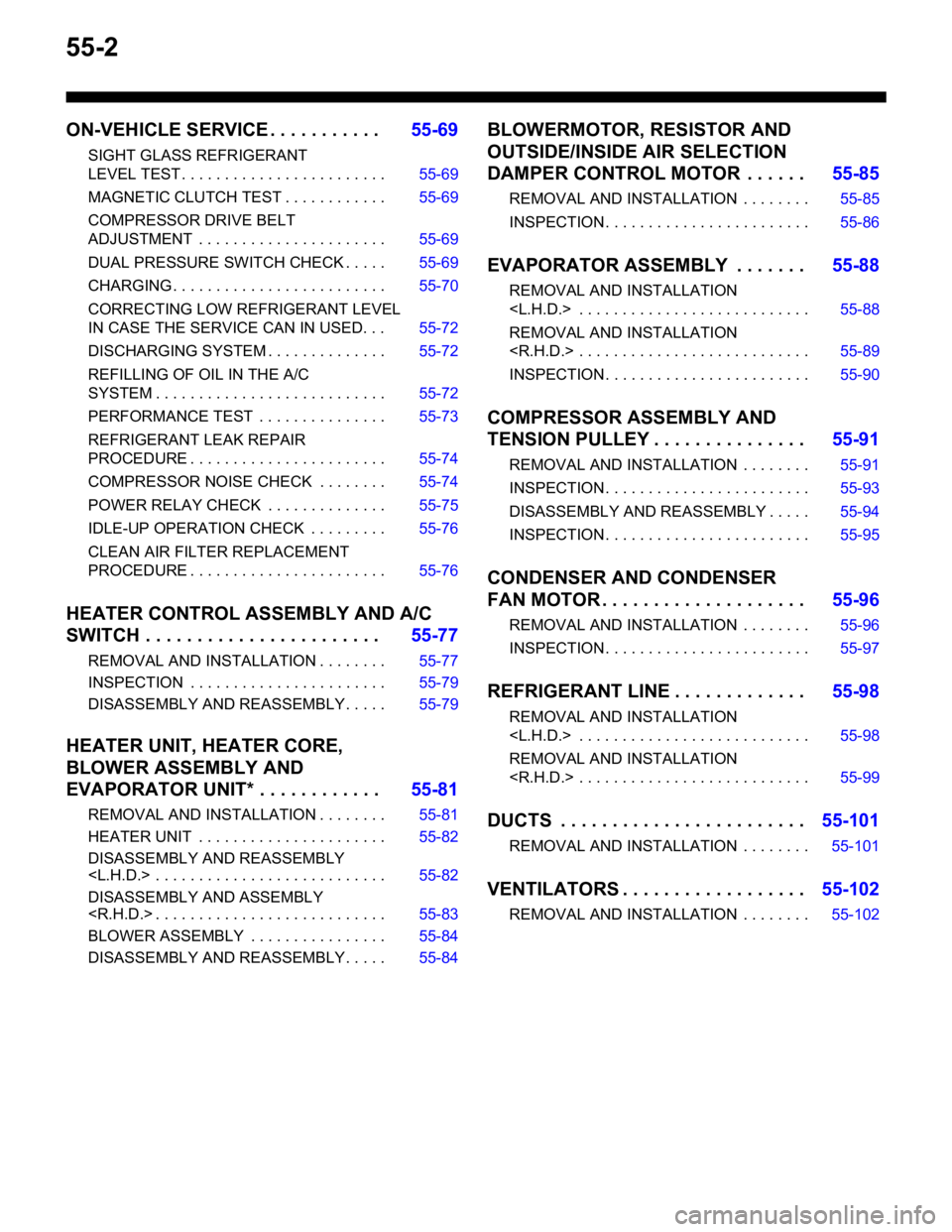
55-2
ON-VEHICLE SERVICE . . . . . . . . . . .55-69
SIGHT GLASS REFRIGERANT
LEVEL TEST . . . . . . . . . . . . . . . . . . . . . . . . 55-69
MAGNETIC CLUTCH TEST . . . . . . . . . . . . 55-69
COMPRESSOR DRIVE BELT
ADJUSTMENT . . . . . . . . . . . . . . . . . . . . . . 55-69
DUAL PRESSURE SWITCH CHECK . . . . . 55-69
CHARGING . . . . . . . . . . . . . . . . . . . . . . . . . 55-70
CORRECTING LOW REFRIGERANT LEVEL
IN CASE THE SERVICE CAN IN USED. . . 55-72
DISCHARGING SYSTEM . . . . . . . . . . . . . . 55-72
REFILLING OF OIL IN THE A/C
SYSTEM . . . . . . . . . . . . . . . . . . . . . . . . . . . 55-72
PERFORMANCE TEST . . . . . . . . . . . . . . . 55-73
REFRIGERANT LEAK REPAIR
PROCEDURE . . . . . . . . . . . . . . . . . . . . . . . 55-74
COMPRESSOR NOISE CHECK . . . . . . . . 55-74
POWER RELAY CHECK . . . . . . . . . . . . . . 55-75
IDLE-UP OPERATION CHECK . . . . . . . . . 55-76
CLEAN AIR FILTER REPLACEMENT
PROCEDURE . . . . . . . . . . . . . . . . . . . . . . . 55-76
HEATER CONTROL ASSEMBLY AND A/C
SWITCH . . . . . . . . . . . . . . . . . . . . . . .55-77
REMOVAL AND INSTALLATION . . . . . . . . 55-77
INSPECTION . . . . . . . . . . . . . . . . . . . . . . . 55-79
DISASSEMBLY AND REASSEMBLY . . . . . 55-79
HEATER UNIT, HEATER CORE,
BLOWER ASSEMBLY AND
EVAPORATOR UNIT* . . . . . . . . . . . .55-81
REMOVAL AND INSTALLATION . . . . . . . . 55-81
HEATER UNIT . . . . . . . . . . . . . . . . . . . . . . 55-82
DISASSEMBLY AND REASSEMBLY
DISASSEMBLY AND ASSEMBLY
BLOWER ASSEMBLY . . . . . . . . . . . . . . . . 55-84
DISASSEMBLY AND REASSEMBLY . . . . . 55-84
BLOWERMOTOR, RESISTOR AND
OUTSIDE/INSIDE AIR SELECTION
DAMPER CONTROL MOTOR . . . . . .55-85
REMOVAL AND INSTALLATION . . . . . . . . 55-85
INSPECTION . . . . . . . . . . . . . . . . . . . . . . . . 55-86
EVAPORATOR ASSEMBLY . . . . . . .55-88
REMOVAL AND INSTALLATION
REMOVAL AND INSTALLATION
INSPECTION . . . . . . . . . . . . . . . . . . . . . . . . 55-90
COMPRESSOR ASSEMBLY AND
TENSION PULLEY . . . . . . . . . . . . . . .55-91
REMOVAL AND INSTALLATION . . . . . . . . 55-91
INSPECTION . . . . . . . . . . . . . . . . . . . . . . . . 55-93
DISASSEMBLY AND REASSEMBLY . . . . . 55-94
INSPECTION . . . . . . . . . . . . . . . . . . . . . . . . 55-95
CONDENSER AND CONDENSER
FAN MOTOR . . . . . . . . . . . . . . . . . . . .55-96
REMOVAL AND INSTALLATION . . . . . . . . 55-96
INSPECTION . . . . . . . . . . . . . . . . . . . . . . . . 55-97
REFRIGERANT LINE . . . . . . . . . . . . .55-98
REMOVAL AND INSTALLATION
REMOVAL AND INSTALLATION
DUCTS . . . . . . . . . . . . . . . . . . . . . . . .55-101
REMOVAL AND INSTALLATION . . . . . . . . 55-101
VENTILATORS . . . . . . . . . . . . . . . . . .55-102
REMOVAL AND INSTALLATION . . . . . . . . 55-102
Page 554 of 788
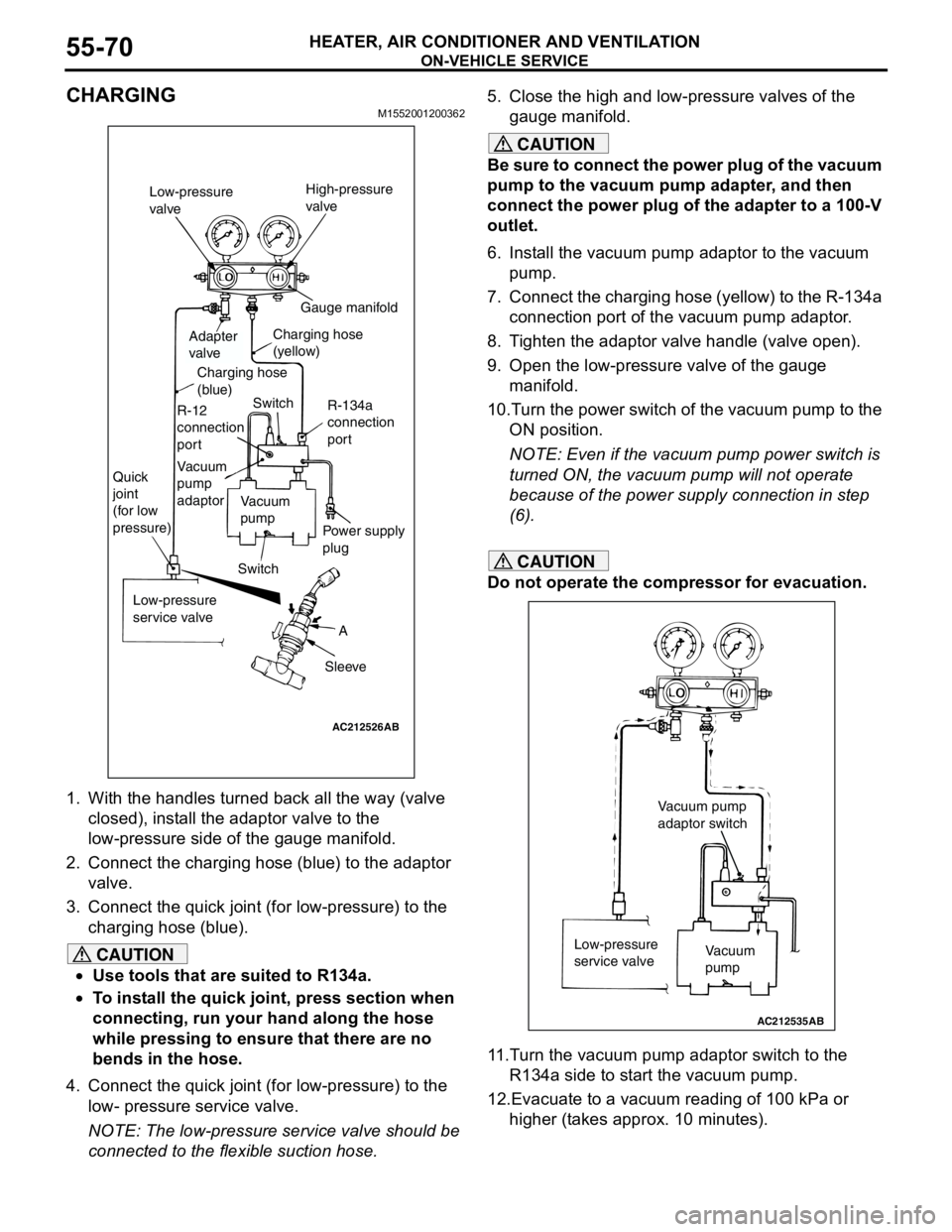
ON-VEHICLE SERVICE
HEATER, AIR CONDITIONER AND VENTILATION55-70
CHARGING M1552001200362
1. With the handles turned back all the way (valve
closed), install the adaptor valve to the
low-pressure side of the gauge manifold.
2. Connect the charging hose (blue) to the adaptor
valve.
3. Connect the quick joint (for low-pressure) to the
charging hose (blue).
CAUTION
•Use tools that are suited to R134a.
•To install the quick joint, press section when
connecting, run your hand along the hose
while pressing to ensure that there are no
bends in the hose.
4. Connect the quick joint (for low-pressure) to the
low- pressure service valve.
NOTE: The low-pressure service valve should be
connected to the flexible suction hose.5. Close the high and low-pressure valves of the
gauge manifold.
CAUTION
Be sure to connect the power plug of the vacuum
pump to the vacuum pump adapter, and then
connect the power plug of the adapter to a 100-V
outlet.
6. Install the vacuum pump adaptor to the vacuum
pump.
7. Connect the charging hose (yellow) to the R-134a
connection port of the vacuum pump adaptor.
8. Tighten the adaptor valve handle (valve open).
9. Open the low-pressure valve of the gauge
manifold.
10.Turn the power switch of the vacuum pump to the
ON position.
NOTE: Even if the vacuum pump power switch is
turned ON, the vacuum pump will not operate
because of the power supply connection in step
(6).
CAUTION
Do not operate the compressor for evacuation.
11.Turn the vacuum pump adaptor switch to the
R134a side to start the vacuum pump.
12.Evacuate to a vacuum reading of 100 kPa or
higher (takes approx. 10 minutes).
AC212526
AB
A
Sleeve Low-pressure
service valve Quick
joint
(for low
pressure)
SwitchVacuum
pump
Power supply
plug Vacuum
pump
adaptor R-12
connection
portCharging hose
(blue)
Adapter
valveCharging hose
(yellow)Gauge manifold
Switch
R-134a
connection
port Low-pressure
valveHigh-pressure
valve
AC212535
Vacuum
pump Low-pressure
service valve
AB
Vacuum pump
adaptor switch
Page 555 of 788
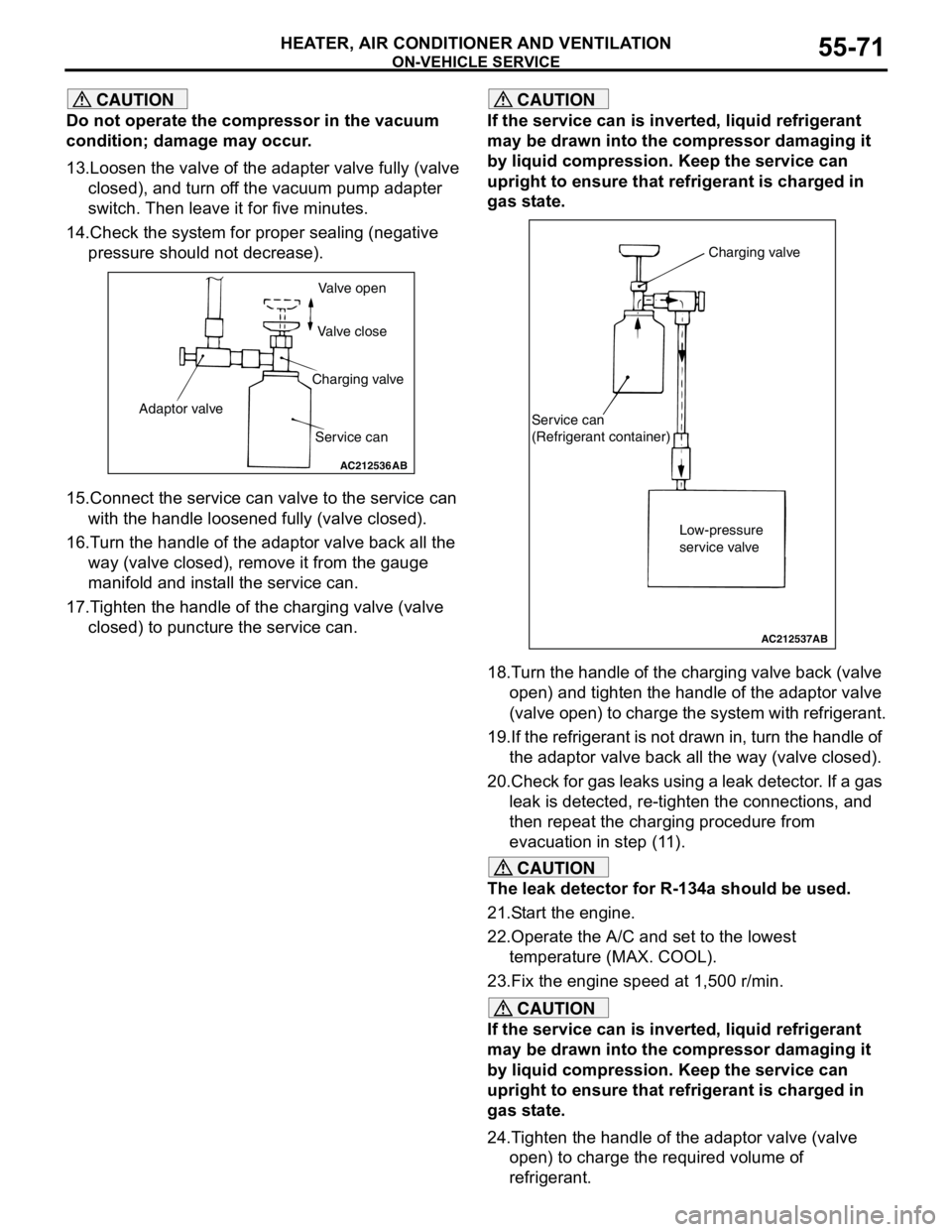
ON-VEHICLE SERVICE
HEATER, AIR CONDITIONER AND VENTILATION55-71
CAUTION
Do not operate the compressor in the vacuum
condition; damage may occur.
13.Loosen the valve of the adapter valve fully (valve
closed), and turn off the vacuum pump adapter
switch. Then leave it for five minutes.
14.Check the system for proper sealing (negative
pressure should not decrease).
15.Connect the service can valve to the service can
with the handle loosened fully (valve closed).
16.Turn the handle of the adaptor valve back all the
way (valve closed), remove it from the gauge
manifold and install the service can.
17.Tighten the handle of the charging valve (valve
closed) to puncture the service can.
CAUTION
If the service can is inverted, liquid refrigerant
may be drawn into the compressor damaging it
by liquid compression. Keep the service can
upright to ensure that refrigerant is charged in
gas state.
18.Turn the handle of the charging valve back (valve
open) and tighten the handle of the adaptor valve
(valve open) to charge the system with refrigerant.
19.If the refrigerant is not drawn in, turn the handle of
the adaptor valve back all the way (valve closed).
20.Check for gas leaks using a leak detector. If a gas
leak is detected, re-tighten the connections, and
then repeat the charging procedure from
evacuation in step (11).
CAUTION
The leak detector for R-134a should be used.
21.Start the engine.
22.Operate the A/C and set to the lowest
temperature (MAX. COOL).
23.Fix the engine speed at 1,500 r/min.
CAUTION
If the service can is inverted, liquid refrigerant
may be drawn into the compressor damaging it
by liquid compression. Keep the service can
upright to ensure that refrigerant is charged in
gas state.
24.Tighten the handle of the adaptor valve (valve
open) to charge the required volume of
refrigerant.
AC212536
Valve open
Valve close
Charging valve
Service can Adaptor valve
AB
AC212537
Charging valve
Service can
(Refrigerant container)
Low-pressure
service valve
AB
Page 556 of 788
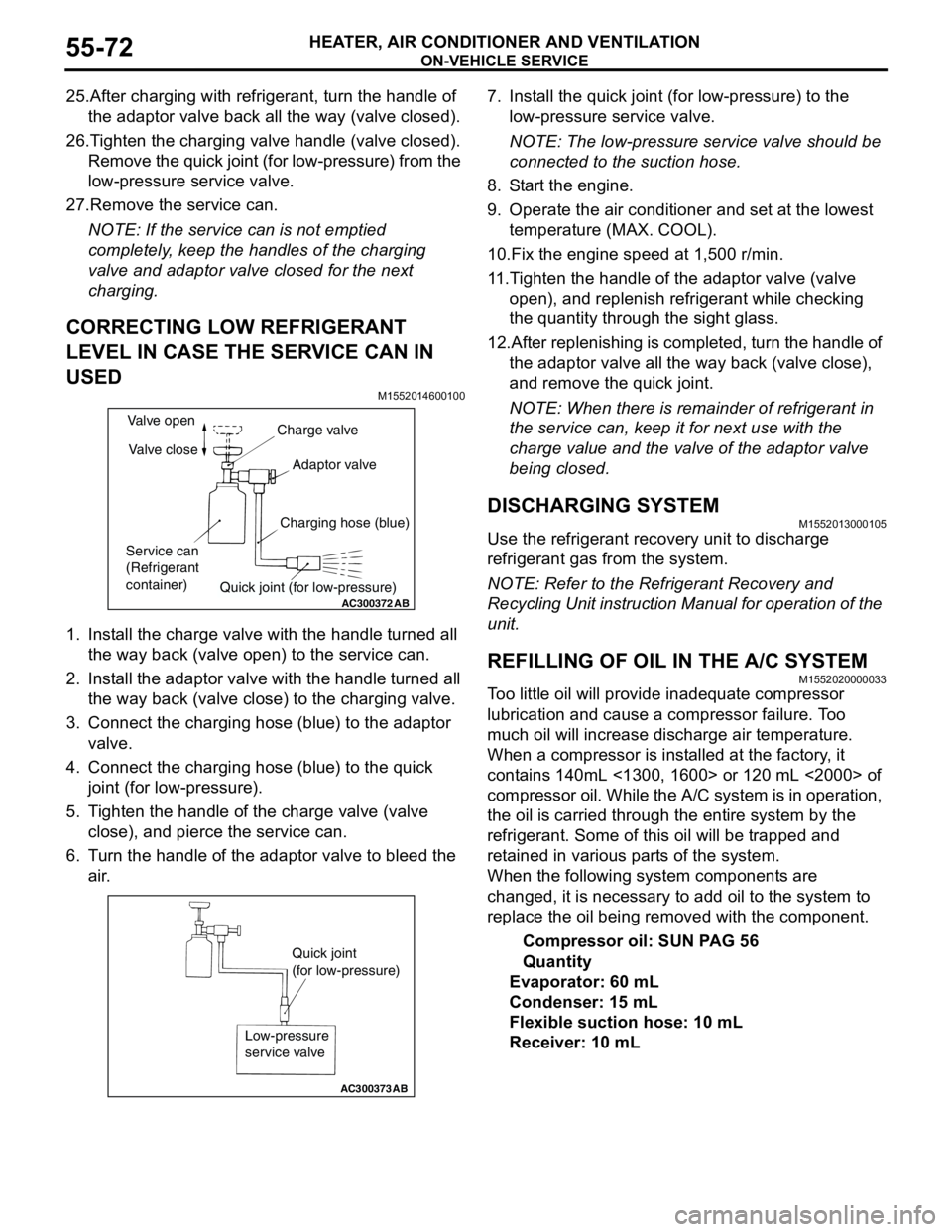
ON-VEHICLE SERVICE
HEATER, AIR CONDITIONER AND VENTILATION55-72
25.After charging with refrigerant, turn the handle of
the adaptor valve back all the way (valve closed).
26.Tighten the charging valve handle (valve closed).
Remove the quick joint (for low-pressure) from the
low-pressure service valve.
27.Remove the service can.
NOTE: If the service can is not emptied
completely, keep the handles of the charging
valve and adaptor valve closed for the next
charging.
CORRECTING LOW REFRIGERANT
LEVEL IN CASE THE SERVICE CAN IN
USED
M1552014600100
1. Install the charge valve with the handle turned all
the way back (valve open) to the service can.
2. Install the adaptor valve with the handle turned all
the way back (valve close) to the charging valve.
3. Connect the charging hose (blue) to the adaptor
valve.
4. Connect the charging hose (blue) to the quick
joint (for low-pressure).
5. Tighten the handle of the charge valve (valve
close), and pierce the service can.
6. Turn the handle of the adaptor valve to bleed the
air.7. Install the quick joint (for low-pressure) to the
low-pressure service valve.
NOTE: The low-pressure service valve should be
connected to the suction hose.
8. Start the engine.
9. Operate the air conditioner and set at the lowest
temperature (MAX. COOL).
10.Fix the engine speed at 1,500 r/min.
11.Tighten the handle of the adaptor valve (valve
open), and replenish refrigerant while checking
the quantity through the sight glass.
12.After replenishing is completed, turn the handle of
the adaptor valve all the way back (valve close),
and remove the quick joint.
NOTE: When there is remainder of refrigerant in
the service can, keep it for next use with the
charge value and the valve of the adaptor valve
being closed.
DISCHARGING SYSTEMM1552013000105
Use the refrigerant recovery unit to discharge
refrigerant gas from the system.
NOTE: Refer to the Refrigerant Recovery and
Recycling Unit instruction Manual for operation of the
unit.
REFILLING OF OIL IN THE A/C SYSTEMM1552020000033
Too little oil will provide inadequate compressor
lubrication and cause a compressor failure. Too
much oil will increase discharge air temperature.
When a compressor is installed at the factory, it
contains 140mL <1300, 1600> or 120 mL <2000> of
compressor oil. While the A/C system is in operation,
the oil is carried through the entire system by the
refrigerant. Some of this oil will be trapped and
retained in various parts of the system.
When the following system components are
changed, it is necessary to add oil to the system to
replace the oil being removed with the component.
Compressor oil: SUN PAG 56
Quantity
Evaporator: 60 mL
Condenser: 15 mL
Flexible suction hose: 10 mL
Receiver: 10 mL
AC300372
AB
Valve open
Valve close
Service can
(Refrigerant
container)Charge valve
Adaptor valve
Charging hose (blue)
Quick joint (for low-pressure)
AC300373
Quick joint
(for low-pressure)
Low-pressure
service valve
AB
Page 557 of 788
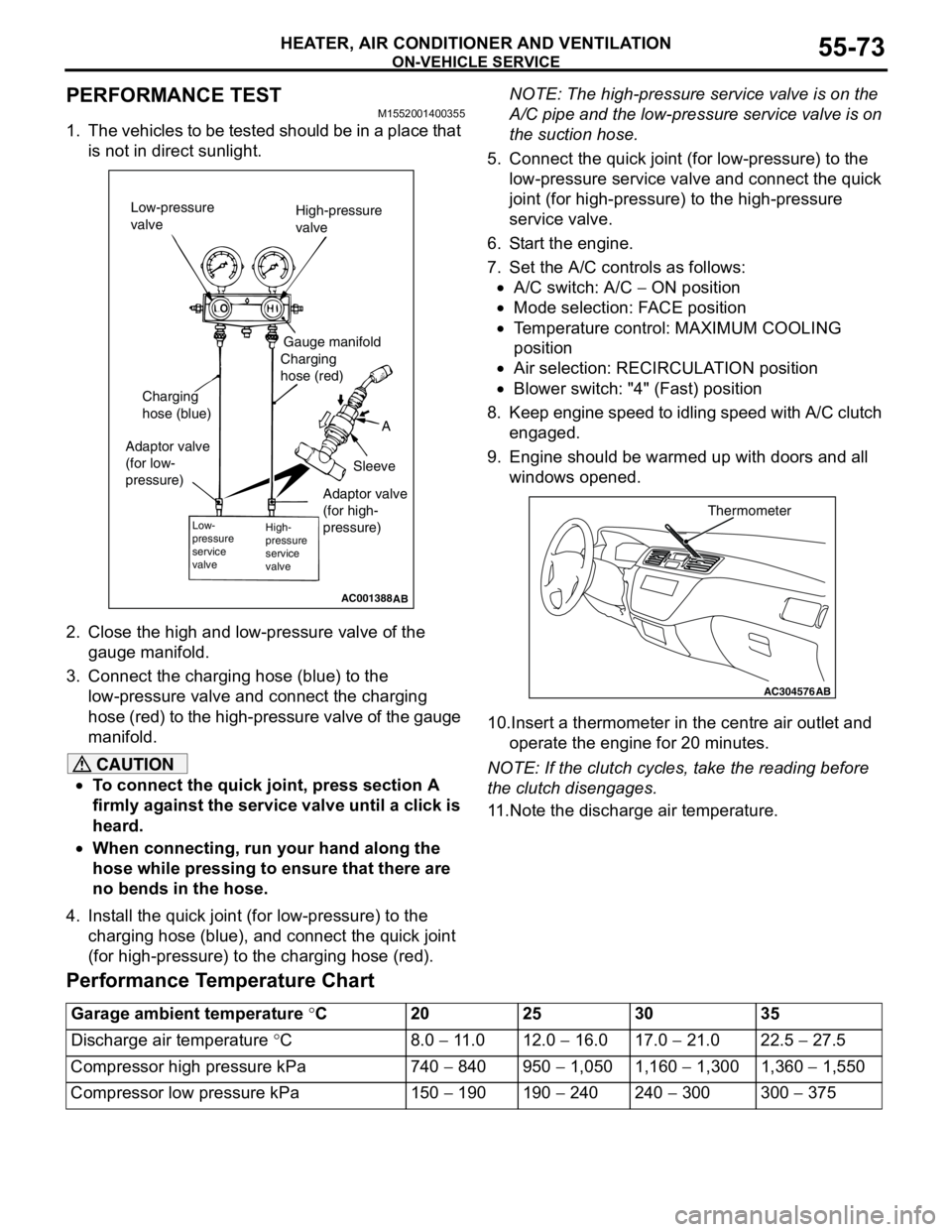
ON-VEHICLE SERVICE
HEATER, AIR CONDITIONER AND VENTILATION55-73
PERFORMANCE TEST M1552001400355
1. The vehicles to be tested should be in a place that
is not in direct sunlight.
2. Close the high and low-pressure valve of the
gauge manifold.
3. Connect the charging hose (blue) to the
low-pressure valve and connect the charging
hose (red) to the high-pressure valve of the gauge
manifold.
CAUTION
•To connect the quick joint, press section A
firmly against the service valve until a click is
heard.
•When connecting, run your hand along the
hose while pressing to ensure that there are
no bends in the hose.
4. Install the quick joint (for low-pressure) to the
charging hose (blue), and connect the quick joint
(for high-pressure) to the charging hose (red).NOTE: The high-pressure service valve is on the
A/C pipe and the low-pressure service valve is on
the suction hose.
5. Connect the quick joint (for low-pressure) to the
low-pressure service valve and connect the quick
joint (for high-pressure) to the high-pressure
service valve.
6. Start the engine.
7. Set the A/C controls as follows:
•A/C switch: A/C − ON position
•Mode selection: FACE position
•Temperature control: MAXIMUM COOLING
position
•Air selection: RECIRCULATION position
•Blower switch: "4" (Fast) position
8. Keep engine speed to idling speed with A/C clutch
engaged.
9. Engine should be warmed up with doors and all
windows opened.
10.Insert a thermometer in the centre air outlet and
operate the engine for 20 minutes.
NOTE: If the clutch cycles, take the reading before
the clutch disengages.
11.Note the discharge air temperature.
Performance Temperature Chart
AC001388
Low-pressure
valveHigh-pressure
valve
Gauge manifold
Charging
hose (red)
A
Sleeve Charging
hose (blue)
Adaptor valve
(for low-
pressure)
Low-
pressure
service
valveHigh-
pressure
service
valve
AB
Adaptor valve
(for high-
pressure)
AC304576
Thermometer
AB
Garage ambient temperature °C20 25 30 35
Discharge air temperature °C8.0 − 11.0 12.0 − 16.0 17.0 − 21.0 22.5 − 27.5
Compressor high pressure kPa 740 − 840 950 − 1,050 1,160 − 1,300 1,360 − 1,550
Compressor low pressure kPa 150 − 190 190 − 240 240 − 300 300 − 375
Page 558 of 788
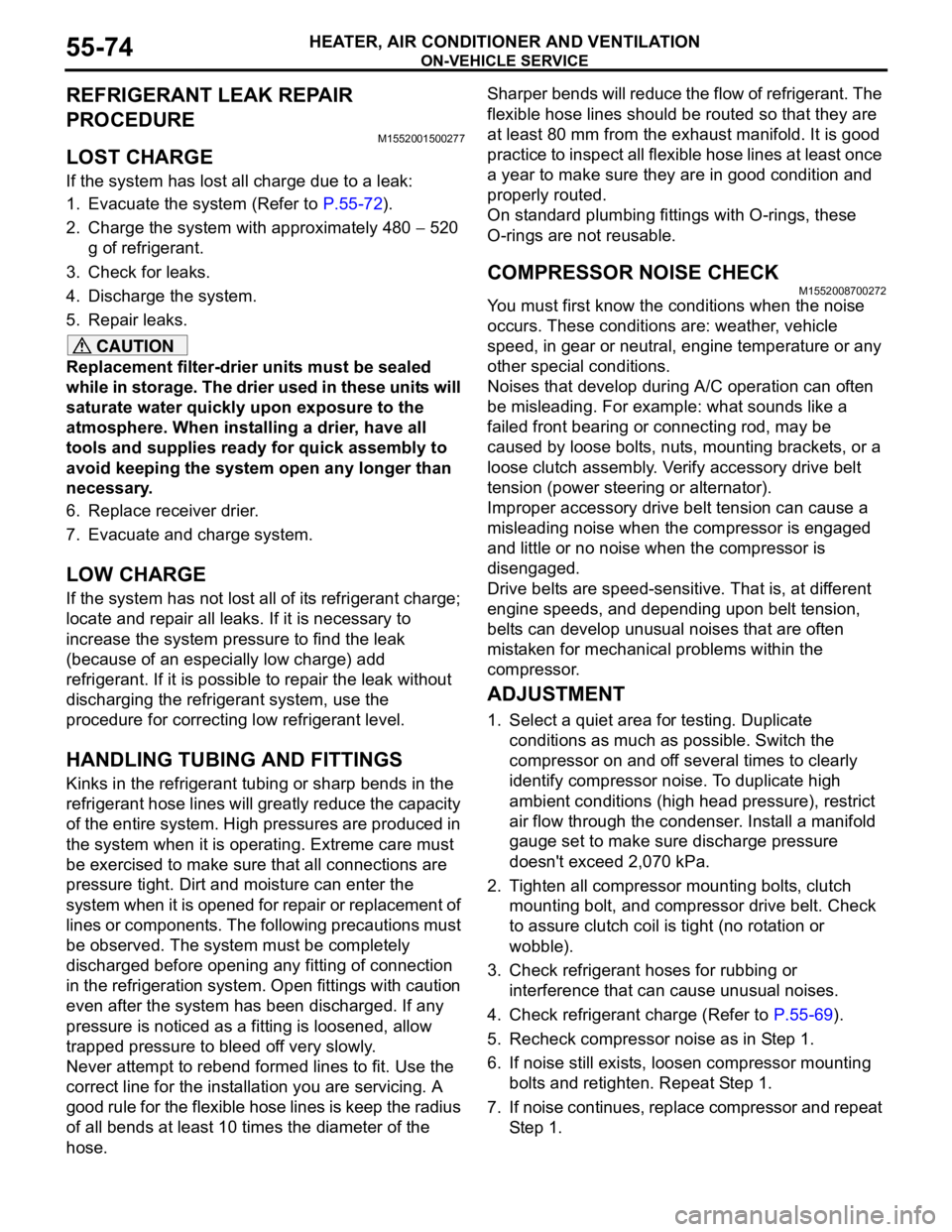
ON-VEHICLE SERVICE
HEATER, AIR CONDITIONER AND VENTILATION55-74
REFRIGERANT LEAK REPAIR
PROCEDURE
M1552001500277
LOST CHARGE
If the system has lost all charge due to a leak:
1. Evacuate the system (Refer to P.55-72).
2. Charge the system with approximately 480 − 520
g of refrigerant.
3. Check for leaks.
4. Discharge the system.
5. Repair leaks.
CAUTION
Replacement filter-drier units must be sealed
while in storage. The drier used in these units will
saturate water quickly upon exposure to the
atmosphere. When installing a drier, have all
tools and supplies ready for quick assembly to
avoid keeping the system open any longer than
necessary.
6. Replace receiver drier.
7. Evacuate and charge system.
LOW CHARGE
If the system has not lost all of its refrigerant charge;
locate and repair all leaks. If it is necessary to
increase the system pressure to find the leak
(because of an especially low charge) add
refrigerant. If it is possible to repair the leak without
discharging the refrigerant system, use the
procedure for correcting low refrigerant level.
HANDLING TUBING AND FITTINGS
Kinks in the refrigerant tubing or sharp bends in the
refrigerant hose lines will greatly reduce the capacity
of the entire system. High pressures are produced in
the system when it is operating. Extreme care must
be exercised to make sure that all connections are
pressure tight. Dirt and moisture can enter the
system when it is opened for repair or replacement of
lines or components. The following precautions must
be observed. The system must be completely
discharged before opening any fitting of connection
in the refrigeration system. Open fittings with caution
even after the system has been discharged. If any
pressure is noticed as a fitting is loosened, allow
trapped pressure to bleed off very slowly.
Never attempt to rebend formed lines to fit. Use the
correct line for the installation you are servicing. A
good rule for the flexible hose lines is keep the radius
of all bends at least 10 times the diameter of the
hose.Sharper bends will reduce the flow of refrigerant. The
flexible hose lines should be routed so that they are
at least 80 mm from the exhaust manifold. It is good
practice to inspect all flexible hose lines at least once
a year to make sure they are in good condition and
properly routed.
On standard plumbing fittings with O-rings, these
O-rings are not reusable.
COMPRESSOR NOISE CHECKM1552008700272
You must first know the conditions when the noise
occurs. These conditions are: weather, vehicle
speed, in gear or neutral, engine temperature or any
other special conditions.
Noises that develop during A/C operation can often
be misleading. For example: what sounds like a
failed front bearing or connecting rod, may be
caused by loose bolts, nuts, mounting brackets, or a
loose clutch assembly. Verify accessory drive belt
tension (power steering or alternator).
Improper accessory drive belt tension can cause a
misleading noise when the compressor is engaged
and little or no noise when the compressor is
disengaged.
Drive belts are speed-sensitive. That is, at different
engine speeds, and depending upon belt tension,
belts can develop unusual noises that are often
mistaken for mechanical problems within the
compressor.
ADJUSTMENT
1. Select a quiet area for testing. Duplicate
conditions as much as possible. Switch the
compressor on and off several times to clearly
identify compressor noise. To duplicate high
ambient conditions (high head pressure), restrict
air flow through the condenser. Install a manifold
gauge set to make sure discharge pressure
doesn't exceed 2,070 kPa.
2. Tighten all compressor mounting bolts, clutch
mounting bolt, and compressor drive belt. Check
to assure clutch coil is tight (no rotation or
wobble).
3. Check refrigerant hoses for rubbing or
interference that can cause unusual noises.
4. Check refrigerant charge (Refer to P.55-69).
5. Recheck compressor noise as in Step 1.
6. If noise still exists, loosen compressor mounting
bolts and retighten. Repeat Step 1.
7. If noise continues, replace compressor and repeat
Step 1.
Page 565 of 788
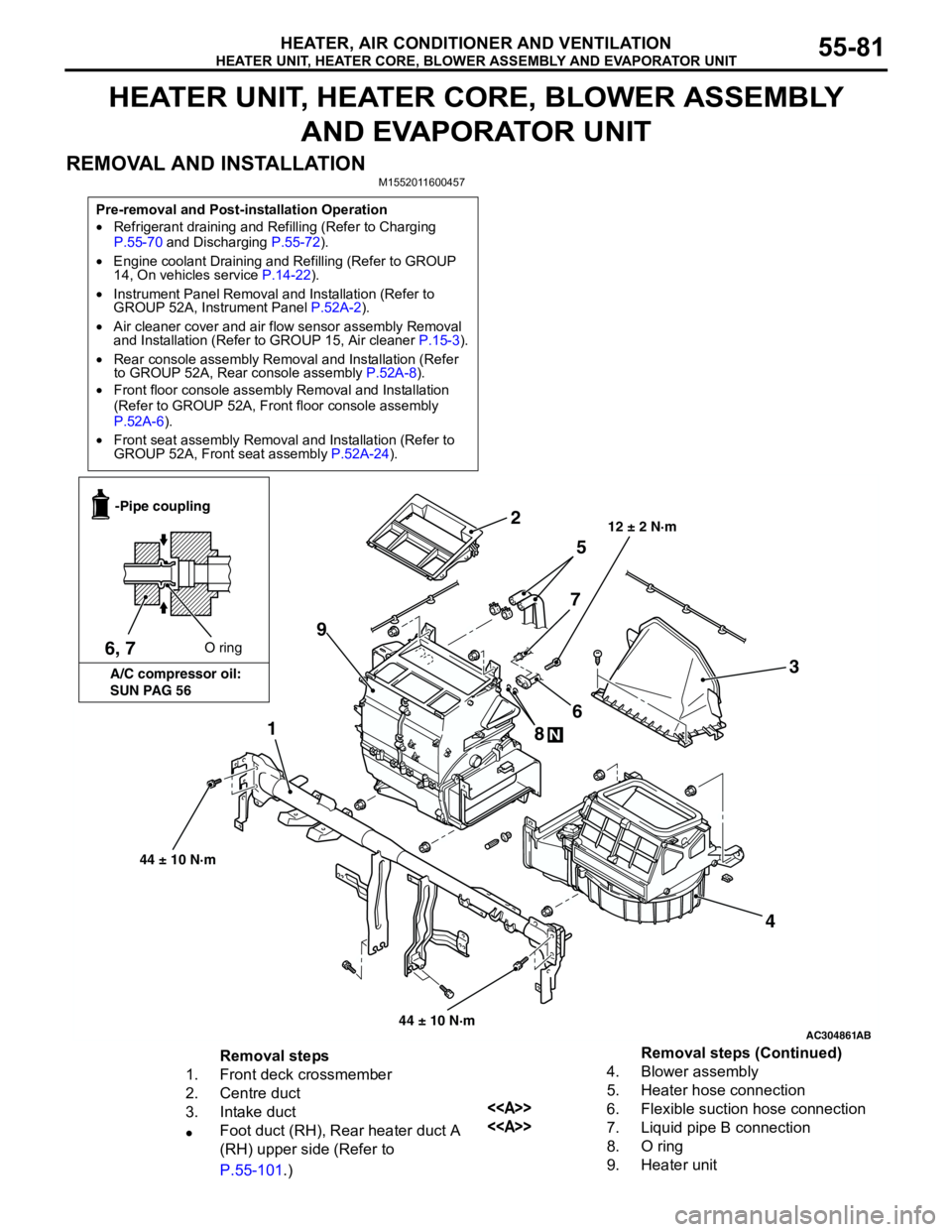
HEATER UNIT, HEATER CORE, BLOWER ASSEMBLY AND EVAPORATOR UNIT
HEATER, AIR CONDITIONER AND VENTILATION55-81
HEATER UNIT, HEATER CORE, BLOWER ASSEMBLY
AND EVAPORATOR UNIT
REMOVAL AND INSTALLATION
M1552011600457
Pre-removal and Post-installation Operation
•Refrigerant draining and Refilling (Refer to Charging
P.55-70 and Discharging P.55-72).
•Engine coolant Draining and Refilling (Refer to GROUP
14, On vehicles service P.14-22).
•Instrument Panel Removal and Installation (Refer to
GROUP 52A, Instrument Panel P.52A-2).
•Air cleaner cover and air flow sensor assembly Removal
and Installation (Refer to GROUP 15, Air cleaner P.15-3).
•Rear console assembly Removal and Installation (Refer
to GROUP 52A, Rear console assembly P.52A-8).
•Front floor console assembly Removal and Installation
(Refer to GROUP 52A, Front floor console assembly
P.52A-6).
•Front seat assembly Removal and Installation (Refer to
GROUP 52A, Front seat assembly P.52A-24).
AC304861
1
2
3
4 5
6
7
8
N
9
AB
12 ± 2 N·m
6, 7O ring -Pipe coupling
A/C compressor oil:
SUN PAG 56
44 ± 10 N·m
44 ± 10 N·m
Removal steps
1. Front deck crossmember
2. Centre duct
3. Intake duct
•Foot duct (RH), Rear heater duct A
(RH) upper side (Refer to
P.55-101.)4. Blower assembly
5. Heater hose connection
<>6. Flexible suction hose connection
<>7. Liquid pipe B connection
8. O ring
9. Heater unitRemoval steps (Continued)
Page 572 of 788
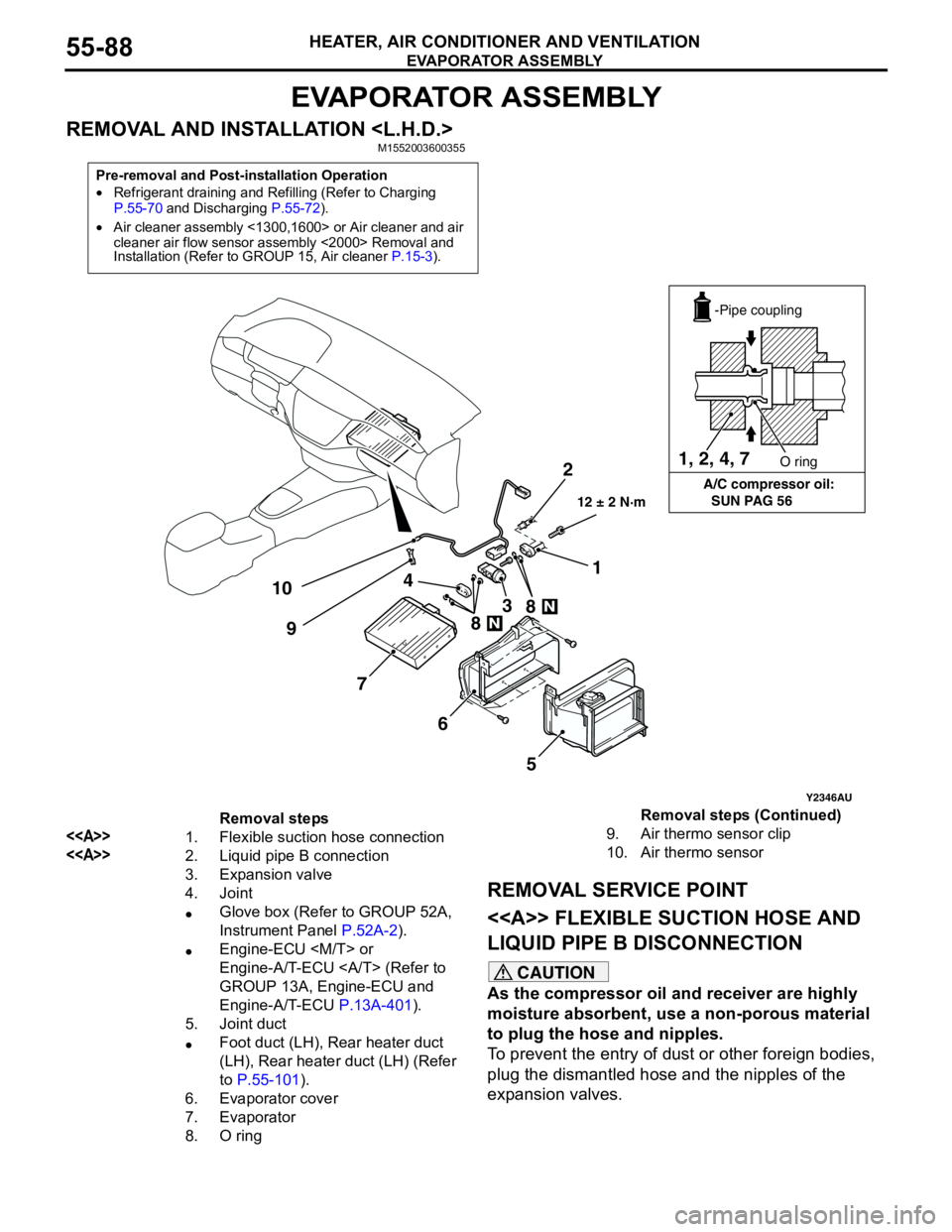
EVAPORATOR ASSEMBLY
HEATER, AIR CONDITIONER AND VENTILATION55-88
EVAPORATOR ASSEMBLY
REMOVAL AND INSTALLATION
REMOVAL SERVICE POINT
<> FLEXIBLE SUCTION HOSE AND
LIQUID PIPE B DISCONNECTION
CAUTION
As the compressor oil and receiver are highly
moisture absorbent, use a non-porous material
to plug the hose and nipples.
To prevent the entry of dust or other foreign bodies,
plug the dismantled hose and the nipples of the
expansion valves.
Pre-removal and Post-installation Operation
•Refrigerant draining and Refilling (Refer to Charging
P.55-70 and Discharging P.55-72).
•Air cleaner assembly <1300,1600> or Air cleaner and air
cleaner air flow sensor assembly <2000> Removal and
Installation (Refer to GROUP 15, Air cleaner P.15-3).
Y2346AU
1, 2, 4, 7
A/C compressor oil:
SUN PAG 56O ring
-Pipe coupling
2
101
3 4
7
6
5 98
8
12 ± 2 N·m
Removal steps
<>1. Flexible suction hose connection
<>2. Liquid pipe B connection
3. Expansion valve
4. Joint
•Glove box (Refer to GROUP 52A,
Instrument Panel P.52A-2).
•Engine-ECU
Engine-A/T-ECU (Refer to
GROUP 13A, Engine-ECU and
Engine-A/T-ECU P.13A-401).
5. Joint duct
•Foot duct (LH), Rear heater duct
(LH), Rear heater duct (LH) (Refer
to P.55-101).
6. Evaporator cover
7. Evaporator
8. O ring 9. Air thermo sensor clip
10. Air thermo sensorRemoval steps (Continued)
Page 573 of 788
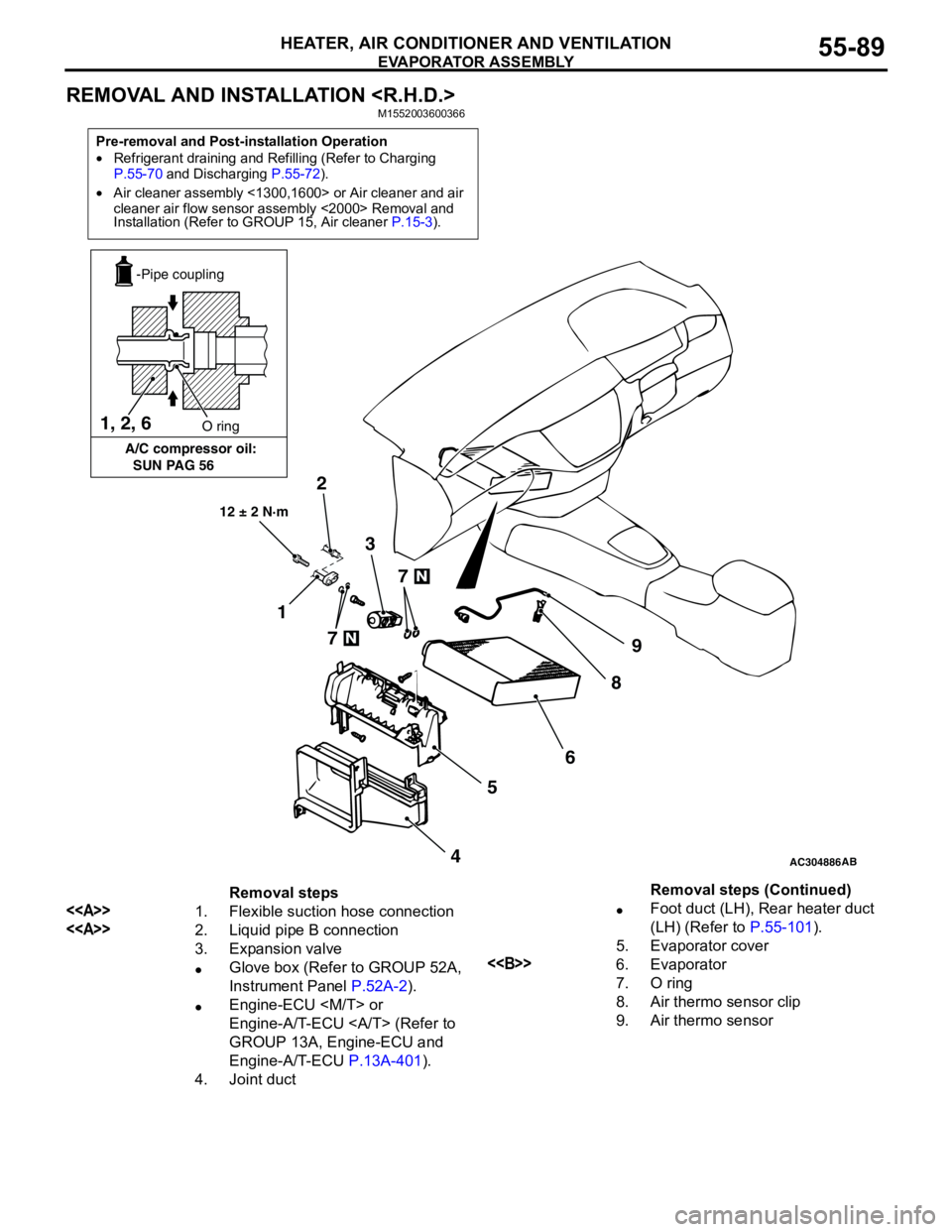
EVAPORATOR ASSEMBLY
HEATER, AIR CONDITIONER AND VENTILATION55-89
REMOVAL AND INSTALLATION
Pre-removal and Post-installation Operation
•Refrigerant draining and Refilling (Refer to Charging
P.55-70 and Discharging P.55-72).
•Air cleaner assembly <1300,1600> or Air cleaner and air
cleaner air flow sensor assembly <2000> Removal and
Installation (Refer to GROUP 15, Air cleaner P.15-3).
AC304886AB
12 ± 2 N·m
7
7
2
1
9
8
6
5
4 3 1, 2, 6
A/C compressor oil:
SUN PAG 56O ring
-Pipe coupling
Removal steps
<>1. Flexible suction hose connection
<>2. Liquid pipe B connection
3. Expansion valve
•Glove box (Refer to GROUP 52A,
Instrument Panel P.52A-2).
•Engine-ECU
Engine-A/T-ECU (Refer to
GROUP 13A, Engine-ECU and
Engine-A/T-ECU P.13A-401).
4. Joint duct•Foot duct (LH), Rear heater duct
(LH) (Refer to P.55-101).
5. Evaporator cover
<>6. Evaporator
7. O ring
8. Air thermo sensor clip
9. Air thermo sensorRemoval steps (Continued)